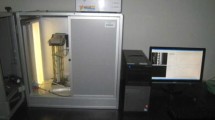Abstract
The foaming properties of anionic surfactant solutions containing a nonionic surfactant, fatty acid N-methyl-ethanolamide (NMEA), were investigated. Foamability, which is the foam-generating power at the initial stage of foaming, was measured by a laboratory-built foam-testing apparatus, and also by the conventional Ross-Miles test NMEA synergistically increased the foamability of anionic surfactant solutions, particularly when small amounts of NMEA were added. Shorter hydrocarbon chain lengths of NMEA, such as N-octanoyl-N-methylethanol (NMEA-08) and N-decanoyl-N-methylethanol (NMEA-10), showed better performance in the laboratory-built foam tester. The results of the Ross-Miles evaluation, however, were completely opposite. Compared with commercial nonionic boosters, such as fatty acid monoethanolamide, fatty acid diethanolamide, and lauramidopropyldimethylbetaine (LPB), NMEA was the most effective for increasing foamability of the solution at the initial stage. The most popular amphoteric foam booster, LPB, did not increase foamability but likely generated the initial foam volume on the Ross-Miles test as a result of foam film stabilization. From these results, a foam-boosting mechanism of NMEA different from that of LPB is suggested.
Similar content being viewed by others
Abbreviations
- CMC:
-
critical micelle concentration
- DEA:
-
dodecanoic acid diethanolamide
- DES2,5:
-
sodium dodecylpolyoxyethylene(2.5) sulfate;
- LPB:
-
lauramidopropyldimethylbetaine
- MEA:
-
coco monoethanolamide
- NMEA:
-
fatty acid N-methylethanolamide (N-hydroxyethyl-N-methylalkanamides)
- NMEA-X:
-
NMEA, where X=8 (octanamide), 10 (decanamide), 12 (dodecanamide), or 14 (tetradecanamide)
References
Hill, R.M., Applications of Surfactant Mixtures, in Mixed Surfactant Systems, edited by K. Ogino and M. Abe, Marcel Dekker, New York, 1992, Vol. 46, p. 317.
Zocchi, G., Foam in Consumer Products, in Handbook of Detergents. Part A: Properties, edited by G. Broze, Marcel Dekker, New York, 1999, Vol. 82, p. 419.
Lomax, E.G., Personal Care Applications, in Amphoteric Surfactants, 2nd edn., edited by E.G. Lomax, Marcel Dekker, New York, 1996, Vol. 59, p. 273.
Guertechin, L.O., Surfactants: Classification, in Handbook of Detergents. Part A: Properties, edited by G. Broze, Marcel Dekker, New York, 1999, Vol. 82, p. 7.
Sanders, H.L. and E.A. Knaggs, Foam Stabilization by Alkylolamides, Soap Sanitary Chem:45 (1953).
Kritchevsky, J., The Alkylolamides, J. Am. Oil Chem. Soc. 34:178 (1957).
Nishioka, G.M., S. Ross, and R.E. Kornbrekke, Fundamental methods for Measuring Foam Stability, in Foams, edited by R.K. Prud’homme and S.A. Khan, Marcel Dekker, New York, 1996, Vol. 57, p. 275.
Tsujii, K., and H. Arai, Effects of pH on Foam Stability of Dimethyldodecylamine Oxide and N-Dodecyl-2-aminopropionic Acid in Aqueous Solutions, J. Am. Oil Chem. Soc. 55:558 (1978).
Tamura, T., Y. Kaneko, and M. Nikaido, Stability Factors of Foam Film in Contrast to Fluctuation Induced by Humidity Reduction, J. Colloids Interface Sci. 190:61 (1997).
Wilson, A.J., Experimental Techniques for the Characterization of Foams, in Foams, edited by R.K. Prud’homme and S.A. Khan, Marcel Dekker, New York, 1996, Vol. 57, p. 243.
Walstra, P., Principles of Foam Formation and Stability, in Foams: Physics, Chemistry and Structure, edited by A.J. Wilson, Springer-Verlag, New York, 1989 p. 1.
Engels, T., H. Hensen, J. Kahre, H. Tesmann, and W.V. Rybinski, Tailoring of Foam Properties, SOFW J. 126:19 (2000).
Burley, R., and M. Shakarin, An Experimental Study of Foam Rheology in Straight Capillary Tubes, Int. J. Eng. Fluid Mech. 5:115 (1992).
Weil, J.K., N. Parris, W.R. Noble, F.D. Smith, and A.J. Stirton, Tallow Alkanolamides: Preparation and Effect on Surfactant Solutions, J. Am. Oil Chem. Soc. 48:674 (1971).
Fukuhara, K., and S. Takaya, Japan Patent JP98-73584A (1998).
Basheva, E.S., S. Stoynov, N.D. Denkov, K. Kasuga, N. Satoh, and K. Tsujii, Foam Boosting by Amphiphilic Molecules in the Presence of Silicone Oil, Langmuir 17:969 (2001).
Domingo, X., Betaines, in Amphoteric Surfactants, 2nd edn., edited by E.G. Lomax, Marcel Dekker, New York, 1996, Vol. 59, p. 75.
Author information
Authors and Affiliations
Corresponding author
About this article
Cite this article
Sakai, T., Kaneko, Y. The effect of some foam boosters on the foamability and foam stability of anionic systems. J Surfact Deterg 7, 291–295 (2004). https://doi.org/10.1007/s11743-004-0314-x
Received:
Accepted:
Issue Date:
DOI: https://doi.org/10.1007/s11743-004-0314-x




